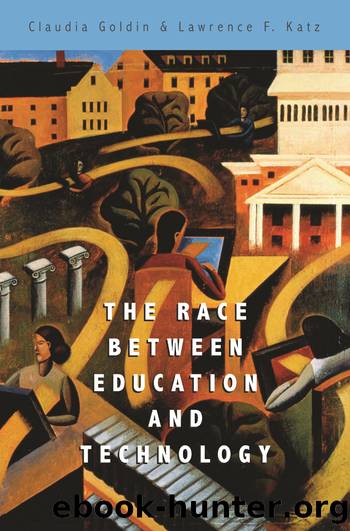The Race between Education and Technology by Claudia Goldin

Author:Claudia Goldin [CSI]
Language: eng
Format: epub
ISBN: 9780674028678
Publisher: Harvard University Press
Published: 2021-06-15T00:00:00+00:00
Regional Differences in State Support
U.S. regions differ greatly in their support for higher education and three different models can be discerned. The Northeast can be thought of as an American elite model, the West as an egalitarian model, and the South as a European elite model. The states of the Northeast founded private institutions early in their histories and their publicsector institutions arose relatively late. When public-sector institutions did appear, they were poorly funded in comparison with other regions. The southern states had a disproportionate share of the earliest public institutions. Of the public institutions that were founded before the American Civil War, fully 57 percent were in the South even though the South had only 36 percent of the private institutions.42 The states of the West, including the Midwest, have a vibrant public sector. Some even have an equally strong private sector. But often in thinly populated western states only a public sector university could survive.
State support for public higher education greatly increased from 1900 to 1940, measured either by the fraction of state spending going to higher education or by the growth of enrollments in public institutions relative to all enrollments or to the college-aged population. For example, total expenditures on state higher-education institutions increased from 5.1 percent to 11.0 percent of state and local government spending from 1902 to 1940.43 But public funding for higher education, and access to public colleges and universities, varied substantially among states throughout the period. The greatest levels of support were found in the Pacific, Mountain, and West North Central states, and the lowest levels of state support were found in New England and the Middle Atlantic states.
Many of the differences in state support for higher education have persistedâthe cross-state correlation between (log) state and local government spending per capita on higher education in 1929 and that in the 1990s was about 0.45, although the correlation decreased somewhat to the early 2000s. It is, therefore, instructive to explore the determinants of state support in the formative years before the expansion of federal support for higher education and just before the effects of the Great Depression on state and local budgets. For these reasons we will examine 1929.44
In 1929, state and local government subsidies to higher education averaged $1,230 (in 2005 dollars) per 100 persons across the 48 states, or 6 percent of total state and local government spending. Almost 95 percent of that state and local support for higher education went to publicly controlled institutions; only New York (Cornell) and New Jersey (Rutgers) had any significant level of state support of privately controlled institutions. State and local spending on higher education per 100 inhabitants ranged from a low of $518 in New England to a high of $2,324 in the Mountain states (all 2005 dollars).45 Enrollments in publicly controlled institutions averaged 3.19 per 1,000 inhabitants: from 0.82 in New England to 6.04 in the Mountain states and 6.09 in the Pacific states. What explains these substantial differences in state support across regions
Download
This site does not store any files on its server. We only index and link to content provided by other sites. Please contact the content providers to delete copyright contents if any and email us, we'll remove relevant links or contents immediately.
Hit Refresh by Satya Nadella(8344)
The Compound Effect by Darren Hardy(7574)
Change Your Questions, Change Your Life by Marilee Adams(6654)
Nudge - Improving Decisions about Health, Wealth, and Happiness by Thaler Sunstein(6642)
The Black Swan by Nassim Nicholas Taleb(6203)
Daring Greatly by Brene Brown(5651)
Deep Work by Cal Newport(5496)
Principles: Life and Work by Ray Dalio(5334)
Rich Dad Poor Dad by Robert T. Kiyosaki(5162)
The Myth of the Strong Leader by Archie Brown(4795)
Man-made Catastrophes and Risk Information Concealment by Dmitry Chernov & Didier Sornette(4748)
Big Magic: Creative Living Beyond Fear by Elizabeth Gilbert(4734)
The Slight Edge by Jeff Olson(4727)
Discipline Equals Freedom by Jocko Willink(4642)
Digital Minimalism by Cal Newport;(4567)
The Motivation Myth by Jeff Haden(4535)
Stone's Rules by Roger Stone(4422)
Management Strategies for the Cloud Revolution: How Cloud Computing Is Transforming Business and Why You Can't Afford to Be Left Behind by Charles Babcock(4135)
The Doodle Revolution by Sunni Brown(4051)
